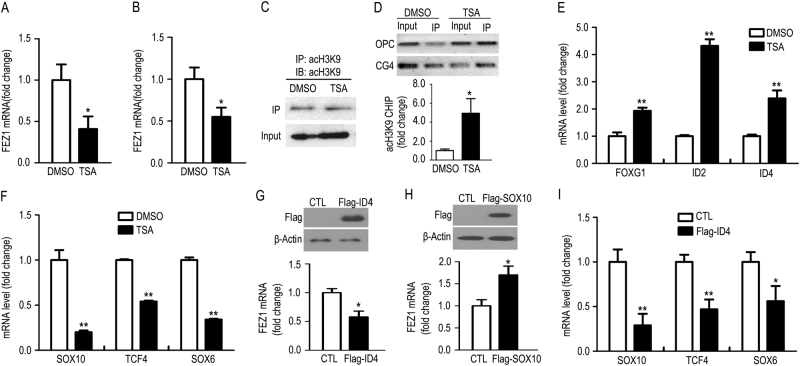Fig. 4.
The cooperation between HDAC-dependent histone acetylation and transcription factors controls FEZ1 expression in OL. a, b FEZ1 mRNA levels in primary cultured OPCs that underwent 5 days of differentiation (DIV5; a; n = 4) and CG4 cells b (n = 5) were treated with TSA or DMSO for 24 h. c Western blot shows comparable efficiency of acH3K9 immunoprecipitation in DMSO or TSA-treated CG4 cells. d Representative illustration of increased acH3K9 at the FEZ1 promoter upon TSA treatment based on ChIP–PCR (upper panel) in rat OL and CG4 cells. ChIP–qPCR quantification of acH3K9 at the FEZ1 promoter in CG4 cells was normalized to the total input of genomic DNA and was graphically displayed (lower panel, n = 7). e, f RT-qPCR quantification of transcription repressor (FOXG1, ID2, ID4) mRNAs e and transcription activator (SOX10, TCF4, SOX6) mRNAs f in DMSO-treated or TSA-treated CG4 cells (n = 5, Welch’s correction was applied). g Representative immunoblot of Flag-ID4 expressed in CG4 cells (upper panel), which leads to downregulation of the FEZ1 mRNA detected by RT-qPCR (lower panel, n = 6 in CTL, n = 8 in Flag-ID4). h Representative immunoblot of Flag-SOX10 in CG4 cells (upper panel), which increases FEZ1 mRNA detected by RT-qPCR (lower panel, n = 5). i Expression of Flag-ID4 in CG4 cells leads to downregulation of the activator TFs (SOX10, TCF4, SOX6) mRNAs detected by RT-qPCR (n = 8 in CTL, n = 6 in Flag-ID4)

